Association analysis for yield and its components in sesame genotypes
Bạn đang xem bản rút gọn của tài liệu. Xem và tải ngay bản đầy đủ của tài liệu tại đây (196.82 KB, 6 trang )
Int.J.Curr.Microbiol.App.Sci (2020) 9(8): 859-863
International Journal of Current Microbiology and Applied Sciences
ISSN: 2319-7706 Volume 9 Number 8 (2020)
Journal homepage:
Original Research Article
/>
Association Analysis for Yield and its Components in Sesame Genotypes
Rajmohan Sharma1* and Mujahida Sayyed2
1
Department of Genetics and Plant Breeding, 2Department of Maths and Statistics, JNKVV,
College of Agriculture, Ganjbasoda (Vidisha) M.P., India
*Corresponding author
ABSTRACT
Keywords
Sesame, Variability,
Association
analysis,
Correlation,
Path analysis
Article Info
Accepted:
10 July 2020
Available Online:
10 August 2020
In the present experiment analysis of association between various plant characters
using correlation and path analysis was studied. Ten sesame genotypes in three
replications were evaluated at the research farm of Agriculture College, Ganjbasoda
during kharif 2018. Observations were recorded for nine characters viz. Plant height,
days to 50% flowering, number of primary branches, days to maturity, length of the
capsule, number of capsules /plant, number of seeds/ capsule, 1000- grain weight and
seed yield/plant. Analysis of variance showed significant differences among all the
genotypes for all the characters under study. Correlation studies indicated that Days to
50 % flowering, days to maturity, plant height, number of capsules per plant and 1000
seed weight with seed yield. Number of capsules per plant had the highest direct effect
on seed yield per plant followed by plant height, 1000 seed weight, days to maturity
and days to 50% flowering.
the states of Gujarat, West Bengal, Uttar
Pradesh, Rajasthan, Madhya Pradesh, Andhra
Pradesh, Maharastra, Tamilnadu, Odisha and
Karnataka, which account for more than 96%
of the total area and production.
Introduction
Sesame (Sesamum indicum L.) is one of the
most important spice and oilseed crop. It is
native to tropic and sub-tropic regions.
Sesame belongs to pedaliaceae family having
chromosome number as (2n=26) and is an
annual, self-pollinated oil seed crop. It’s
known by various names such as sesamum,
til, gingelly, simsim, gergelim etc. Sesame is
the sixth most important oilseed crop in the
world after soybean, rapeseed, cottonseed,
sunflower and groundnut. India is the world
leader in the area and production of sesame.
India is the highest producer of sesame in the
world. It is grown as a rain fed crop mainly in
Sesame is grown mainly for its seeds that
contain approximately 50% oil and 25%
protein. Due to the high stability of its oil
with distinct sweet flavor, sesamum is
regarded as the ‘Queen of Oilseeds’. The
presence of antioxidants (sesamolin and
sesamol) makes the oil to be one of the most
stable vegetable oils in the world. Sesamum
oil is highly resistant to oxidative
deterioration even though oleic and linoleic
859
Int.J.Curr.Microbiol.App.Sci (2020) 9(8): 859-863
acids are the predominant fatty acids (about
80% of its total) of sesame oil, (Uzun et al.,
2007). The high level of unsaturated fat
increases the quality of sesame oil for human
consumption.
Observations were recorded for nine
characters viz. days to 50% flowering, days to
maturity, plant height (cm), number of
primary branches/ plants, number of
capsules/plants, capsule length (cm.) no. of
seeds/capsule, 1000 seed weight (g) and seed
yield/plant (g.). Recommended package of
practices was adopted in respect of irrigation,
weeding and fertilizing.
Seed yield being a complex character is
influenced
by
various
components.
Determination of seed yield components and
suitable character combination that affects
yield to a maximum extent is important in
formulating an effective breeding program.
Results and Discussion
Analysis of variance revealed that highly
significant differences among all the
characters under study (Table 1) indicating
considerable amount of genetic variation
present in the material. High magnitude of
variation in the experimental material was
reflected by high value of mean and range for
almost all the characters.
Hence, the present investigation was carried
out to gather information on character
association and path co-efficient analysis in
10 diverse germplasm collections of sesme.
Materials and Methods
Ten diverse genotypes were evaluated during
kharif 2018 at Instructional Farm of JNKVV,
College of Agriculture, Ganjbasoda. All the
genotypes were grown in randomized block
design with three replications. Row to row
distance of 45 cm. and plant to plant of 10
cm. was maintained. Ten plants from each
replication were randomly selected for
recording observation.
Study of the association of yield components
with yield is useful for choosing the
characters, which have a definite role in
influencing the yield and may aid in selection
from the breeding material. A better
understanding of the contribution of such
traits in building up the genetic makeup of the
crop may be obtained through correlation.
Table.1 Analysis of variance for different characters in sesame
Characters
Days to 50% flowering
Days to maturity
Plant height (cm)
No. of primary branches/ plant
No. of capsules/ plant
Capsule length (cm)
No. of seeds/ capsule
1000 seed weight (g)
Seed yield/ plant (g)
860
Mean squares
78.67**
104.75**
858.92**
1.10*
534.90*
0.08*
431.11**
0.41*
29.65***
Int.J.Curr.Microbiol.App.Sci (2020) 9(8): 859-863
Table.2 Phenotypic and genotypic correlation coefficient between seed yield per plants and its components in sesame
Genotypes
Days to 50%
flowering
Days to maturity
Plant height (cm)
No. of primary
branches/ plant
No. of capsules/
plant
Capsule length (cm)
No. of seeds/ capsule
1000 seed weight (g)
Phenotypic/
Genotypic
Days to
maturity
Plant height
(cm)
No. of primary
branches/ plant
No. of capsules/
plant
Capsule length
(cm)
No. of Seeds/
capsule
1000 seed
weight (g)
Seed yield/
plant (g)
P
0.83***
0.45*
-0.08
0.29
0.25
0.17
0.10
0.48**
G
0.87***
0.47*
-0.10
0.29
0.27
0.16
0.11
0.49**
P
0.52**
-0.17
0.27
0.15
0.04
0.38*
0.47**
G
0.52**
-0.10
0.20
0.15
0.04
0.39*
0.50**
P
0.55**
073***
-0.30
-0.52
0.23
0.59***
G
0.58**
0.75***
-0.32
-0.53
0.24
0.61***
P
0.73***
-0.51**
-0.69***
-0.25
0.22
G
0.75***
-0.61**
-0.73***
-0.27
0.23
P
-0.49**
-0.36
0.13
0.76***
G
-0.53**
-0.37
0.13
0.78***
P
0.69***
0.18
-0.07
G
0.73***
0.18
-0.09
P
0.26
0.19
G
0.26
0.18
P
0.55**
G
0.55**
P = Phenotypic correlation G = Genotypic correlation
* Significant at 5% level, ** Significant at 1% level, *** Significant at 0.1% level
861
Int.J.Curr.Microbiol.App.Sci (2020) 9(8): 859-863
Table.3 Direct (diagonal) and indirect effects of characters on seed yield per plant at Phenotypic and genotypic level in sesame
Genotypes
Phenotypic/
Genotypic
Days to 50%
flowering
Days to maturity
Plant height (cm)
No. of primary
branches/ plant
No. of capsules/
plant
Capsule length
(cm)
No. of seeds/
capsule
1000 seed weight
(g)
Days to
50%
flowering
Days to
maturity
Plant
height (cm)
No. of primary
branches/ plant
No. of
capsules/
plant
Capsule
length (cm)
No. of
Seeds/
capsule
1000 seed
weight (g)
Seed
yield/
plant (g)
P
0.11
0.09
0.05
-0.01
0.03
0.03
0.02
0.11
0.48
G
0.21
0.19
0.10
-0.02
0.06
0.06
0.03
0.02
0.49
P
-0.06
-0.08
-0.04
0.01
-0.02
-0.01
-0.00
-0.03
0.47
G
-0.37
-0.42
-0.22
0.08
-0.11
-0.06
-0.01
-0.17
0.50
P
0.15
0.17
0.32
0.18
0.24
-0.09
-0.17
0.07
0.59
G
0.02
0.02
0.04
0.02
0.03
-0.01
-0.02
0.01
0.61
P
0.00
0.00
-0.02
-0.04
-0.02
0.02
0.03
0.01
0.22
G
0.09
0.17
-0.53
-0.92
-0.69
0.56
0.67
0.24
0.22
P
0.19
0.17
0.47
0.47
0.64
-0.31
-0.23
0.08
0.76
G
0.45
0.41
1.15
1.16
1.54
-0.82
-0.56
0.19
0.78
P
-0.03
-0.02
0.04
0.07
0.06
-0.14
-0.09
-0.02
-0.07
G
0.07
0.04
-0.08
-0.16
-0.14
0.27
0.20
0.05
-0.09
P
0.09
0.02
-0.30
-0.40
-0.21
0.39
0.57
0.15
0.18
G
-0.03
-0.00
0.09
0.13
0.06
-0.13
-0.18
-0.05
0.18
P
0.03
0.10
0.06
-0.07
0.03
0.05
0.07
0.26
0.54
G
0.02
0.00
0.06
0.06
0.03
0.04
0.06
0.22
0.55
P = Phenotypic Correlation, G= Genotypic Correlation
Residual effect for phenotypic path = 0.19, Residual effect for genotypic path = 0.11
862
Int.J.Curr.Microbiol.App.Sci (2020) 9(8): 859-863
Phenotypic and genotypic correlations
between seed yield per plant with different
yield attributes and among the attributes
themselves are presented in Table 2. Days to
50 % flowering showed positive and
significant correlation with days to maturity
(0.83***, 0.45**), plant height (0.45*, 0.47*)
and seed yield per plant (0.48**, 0.49**) at
both phenotypic and genotypic level.
Thirumala Rao et al., (2013), Vanishree et al.,
(2013) and Bharathi et al., (2015) also
reported positive and significant correlation
between days to 50% flowering and for days
to maturity.
Number of capsules per plant is positively
correlated with seed yield per plant (0.76***,
0.78***) similar results were reported by
Mahmoud et al., (2015) for seed yield. While
it is negatively correlated with capsule length
(-0.49**, -0.53**)
Positive and highly significant phenotypic and
genotypic correlation was observed between
capsule length and number of seeds per
capsule (0.69***, 0.73***). 1000 seed weight
and seed yield per plant is also positively
correlated (0.55**, 0.55**). These results are
in accordance with Vanishree et al., (2013),
Bharathi et al., (2015) and Fazal et al.,
(2015).
Days to maturity exhibited positive and
significant correlation with plant height
(0.52**, 0.52**), 1000 seed weight (0.38*,
0.39*) and seed yield per plant (0.47**,
0.50**) at both phenotypic and genotypic
level. These results are in agreement with
Vanishree et al., (2013) and Bharathi et al.,
(2015) for plant height.
Plant height exhibited positive and significant
phenotypic and genotypic correlation with
number of primary branches per plant
(0.55***, 0.58***), number of capsules per
plant (0.73***, 0.75***) and seed yield per
plant (0.59***, 0.61***). The positive
significant association of plant height with
number of branches per plant, number of
capsules per plant and seed yield per plant
was also reported by Fazal et al., (2015).
Path coefficient analysis provides a more
realistic picture of the relationship, as it
considers direct as well as indirect effects of
the variables by partitioning the correlation
coefficients (Sodavadiya et al., 2009; Ali et
al, 2009). Thus, it provides a clear idea about
the highest contributing character to seed
yield and relative importance of each
character can then be estimated. Results of
path analysis (Table 3) showed that number of
capsules per plant had highest direct effect on
seed yield per plant followed by plant height,
1000 seed weight, days to maturity and days
to 50% flowering. Vanishree et al., (2013),
Abate and Mekbib (2015), Bharathi et al.,
(2015) and Fazal et al., (2015) also reported
same findings.
Positive and highly significant phenotypic and
genotypic correlation was observed between
number of primary branches per plant and
number of capsules per plant (0.73***,
0.75***) while number of primary branches
per plant is negatively correlated with capsule
length (-0.51**, -0.61**). Gangadhara et al.,
(2012) also reported Positive and highly
significant correlation between number of
primary branches per plant and number of
seeds per capsule.
In conclusion the correlation studies indicated
that Days to 50 % flowering, days to maturity,
plant height, number of capsules per plant and
1000 seed weight with seed yield. Path
analysis showed that number of capsules per
plant had highest direct effect on seed yield
per plant followed by plant height, 1000 seed
weight, days to maturity and days to 50%
flowering therefore simultaneous selection of
these traits will helpful in identifying high
yielding genotypes.
863
Int.J.Curr.Microbiol.App.Sci (2020) 9(8): 859-863
Rajesh,
A.M.
2012.
Genetic
divergence, genetic advance and
heritability in sesame (Sesamum
indicum L.). BioInfolet. 9 (5): 437-462.
Mahmoud, M.W.SH., Elezz, A.A and Hassan,
T.H.A. 2015. Genetic variability,
heritability and correlation coefficients
of yield and its component in sesame.
Egypt Journal of Plant Breeding.
19(4):1101-1116.
Sodavadiya PR, Pithia MS, Savaliya JJ,
Pansuriya AG and Korat VP 2009.
Studies on characters association and
path analysis for seed yield and its
components in pigeonpea (Cajanus
cajan (l.) Millsp.). Legume Research.
32:203-205.
Thirumala Rao.V., D. Bharathi, Y. Chandra
Mohan, V. Venkanna and D. Bhadru.
2013.
Genetic
variability
and
association analysis in sesame.
(Sesamum indicum L.). Crop Research.
46 (1, 2 & 3): 122-125.
Vanishree, Lokesha, R., Goudappagoudra, R
and Chetankumar. NB. 2013. Analysis
of genetic variability for yield and its
components in xviii sesame (Sesamum
indicum L.) International Journal of
Plant Sciences. 8(1): 91-93.
References
Abate, M and Mekbib, F. 2015. Assessment
of genetic variability and character
association in Ethiopian low altitude
sesame (Sesamum indicum L.)
genotypes. Journal of Advanced
Studies in Agricultural, Biological and
Environmental Sciences. 2(3) 55-66.
Ali MA, Nawab NN, Abbas A, Zulkiffal M
and Sajjad M 2009. Evaluation of
selection criteria in Cicer arietinum L
using correlation coefficients and path
analysis. Australian Journal of Crop
Science. 3: 65-70.
Bharathi, D., Tirumalarao, V., Venkanna, V
and Bhadru, D. 2015. Association
analysis in sesame (Sesamum indicum
L.). International Journal of Applied
Biology
and
Pharmaceutical
Technology. 6 (1): 210-212.
Fazal, A., Mustafa, H.S.B., Fasan, E.U.,
Anwar, M., Tahir, M.H.N. and Sadaqat,
H.A. 2015. Interrelationship and path
coefficient analysis among yield and
yield related traits in sesame (Sesamum
indicum L.). Nature and Science.
13(5): 27-32.
Gangadhara, J., Prakash, C., Badiger, B,
Shadakshari, T.V., Yathish, K.R and
How to cite this article:
Rajmohan Sharma and Mujahida Sayyed. 2020. Association Analysis for Yield and its
Components in Sesame Genotypes. Int.J.Curr.Microbiol.App.Sci. 9(08): 859-863.
doi: />
864
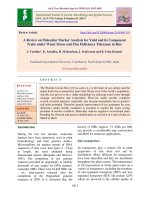
![Studies on correlation and path analysis for grain yield and quality components in foxtail millet [Setaria italica (L.) Beauv.]](https://media.store123doc.com/images/document/2020_01/09/medium_dyd1578574836.jpg)
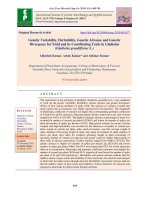
![Genetic variability studies in F2 segregating populations for yield and its component traits in Okra [Abelmoschu sesculentus (L.)Moench]](https://media.store123doc.com/images/document/2020_01/13/medium_nxs1578931693.jpg)
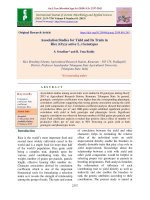
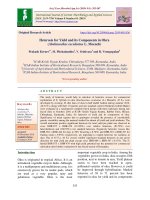
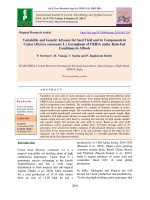
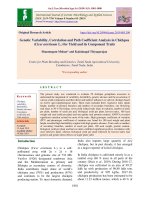
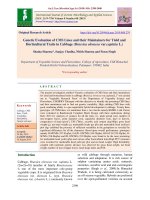
![Studies on combining ability for yield and its component traits in rabi sorghum [Sorghum bicolor (L.) Moench]](https://media.store123doc.com/images/document/2020_03/02/medium_mzw1583124925.jpg)